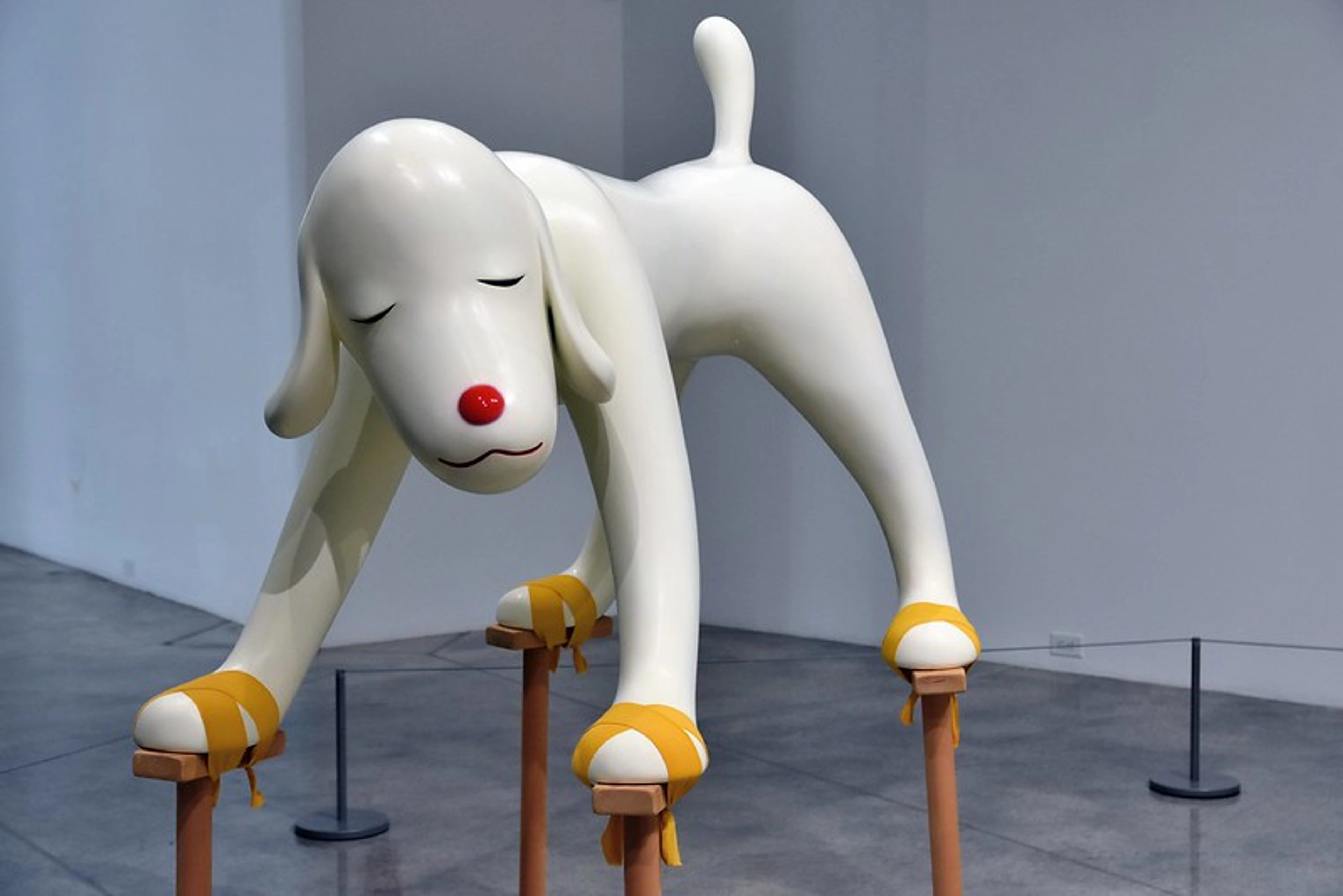
Yoshitomo Nara: An Extended Guide to His Art, Style & Influence
Dive deeper into Yoshitomo Nara's art with this extended guide. Explore his solitary childhood, punk influences, iconic characters, and the complex emotions behind the cute facade, all through a personal lens.
Yoshitomo Nara: The Ultimate Guide to His Art, Style & Influence
Have you ever stood in front of a painting that just... gets you? That feels both incredibly simple and surprisingly complex, like a quiet hum of emotion you didn't realize you were carrying? For me, encountering the work of Yoshitomo Nara often feels exactly like that. Yoshitomo Nara (born 1959) is one of Japan's most beloved and internationally renowned contemporary artists. Instantly recognizable for his depictions of wide-eyed children and animals, Nara's work masterfully blends a deceptively simple, cartoonish aesthetic with complex undercurrents of emotion – ranging from anger, defiance, and loneliness to quiet contemplation and resilience. His unique visual language, deeply influenced by punk rock, childhood memory, and folk art, has resonated globally, making him a pivotal figure in contemporary art and highly sought after on the art market.
This ultimate guide provides a comprehensive exploration of Yoshitomo Nara, delving into his formative experiences, distinctive artistic style across various media, the recurring motifs and themes that define his oeuvre, his diverse influences, market impact, and enduring legacy. It's a journey into the quiet, sometimes loud, inner world he brings to life.
Biography: Roots of Rebellion and Solitude
Nara's distinctive artistic voice is profoundly shaped by his personal history, which feels like the bedrock of everything he creates:
- Childhood in Hirosaki (Born 1959): Born in Hirosaki, a relatively remote city in northern Japan, Nara described himself as a "latchkey kid." Both parents worked, leaving him frequently alone. This early solitude wasn't just about being physically by himself; it was a deep, quiet space that fueled his imagination and forced him inward. He entertained himself through drawing, interacting with animals (especially a neighbourhood cat – I can just picture him, a small figure finding solace with a feline friend), and immersing himself in music via the radio (American Forces Network). These experiences of isolation and self-reliance became foundational themes in his later work, shaping that inner world we see reflected in his solitary figures. He's even shared memories of talking to animals or objects when alone, a quiet dialogue that perhaps finds its way into the silent communication of his characters.
- Art Education: Nara pursued formal art training, graduating from the Aichi Prefectural University of Fine Arts and Music in Japan. Seeking further development and distance, he moved to Germany in 1988 to study at the prestigious Kunstakademie Düsseldorf under A.R. Penck. This period (until 2000) was crucial. Moving to a new country alone? That's a brave leap, isn't it? It forces introspection, makes you really look at yourself and your place in the world. This experience, combined with exposure to Neo-Expressionism and the European art scene, helped him refine his unique style and thematic concerns, solidifying that distinct, personal voice. Penck himself, known for his own raw, pictographic style, likely encouraged Nara's move towards direct, simplified forms loaded with meaning. Nara has spoken about how this time allowed him to break away from more traditional Japanese art structures and embrace a rawer, more direct form of expression, exploring concepts of line and form in a new way.
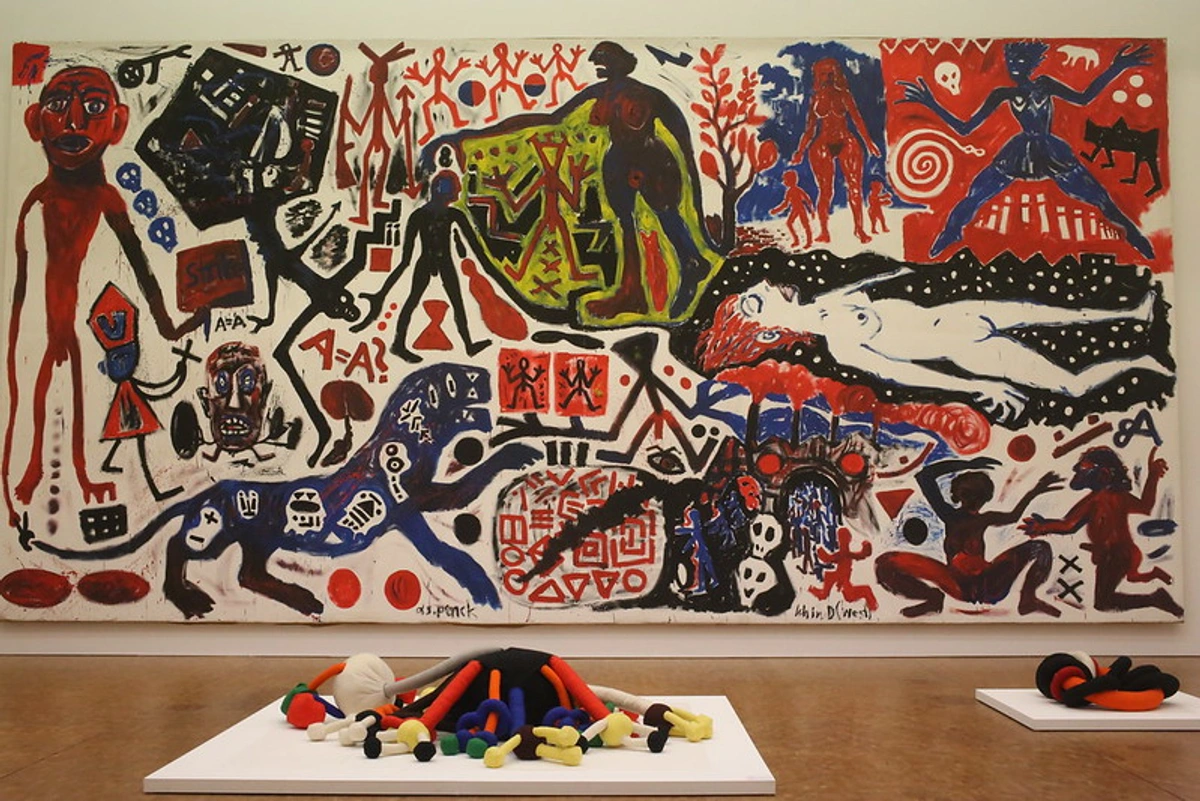
- Return and Recognition: After returning to Japan in 2000, Nara's international reputation soared. He became associated with the Neo-Pop movement in Japan, although his work maintained a distinct, personal emotional depth. Major solo exhibitions at prominent galleries and museums worldwide cemented his status as a leading contemporary artist.
- Studio Life: Nara is known for working primarily from his studio in Tochigi Prefecture, north of Tokyo. Stepping into his creative space, even just in photos, feels like a personal glimpse. Music remains a vital part of his creative process; his studio is famously filled with records, the soundtrack to his thoughts. His artistic development mirrors the kind of dedicated personal evolution detailed in many artists' journeys. It feels less like just 'work' and more like a dedicated, almost ritualistic process of bringing his inner world to life.
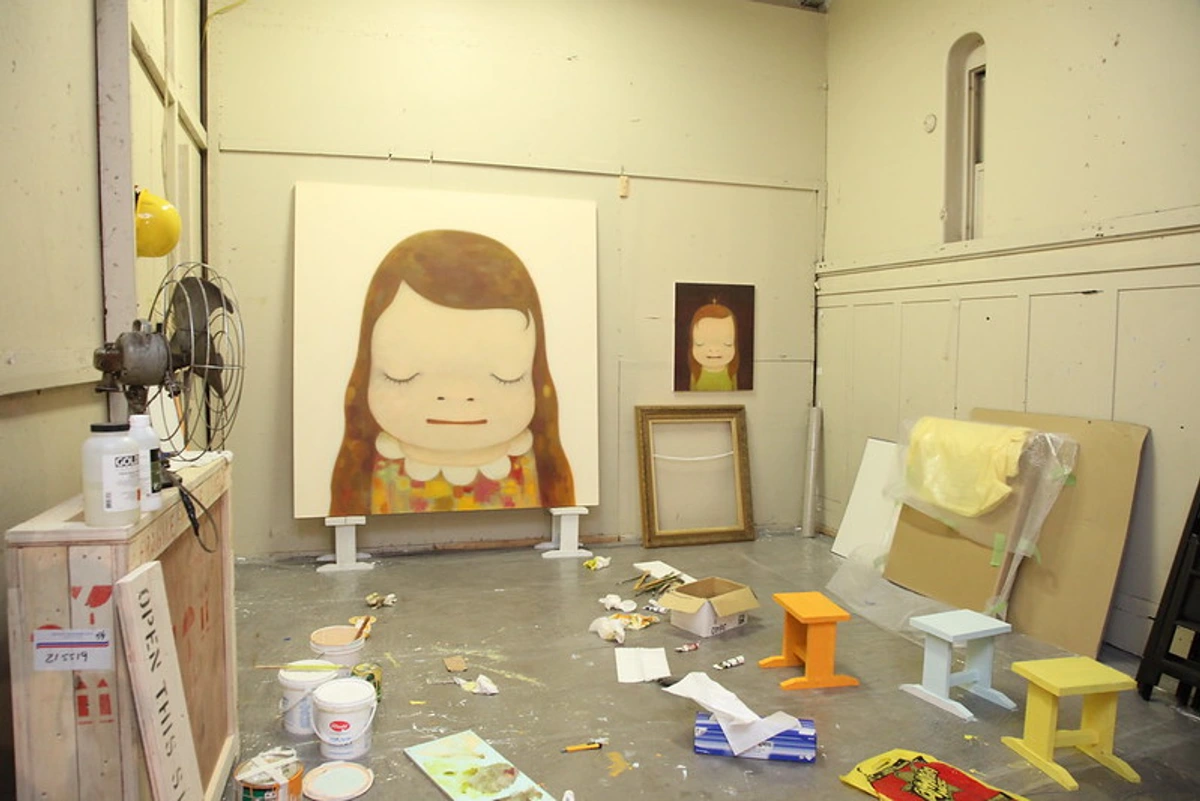
- Impact of 2011 Earthquake: The devastating Tōhoku earthquake and tsunami in 2011 deeply affected Nara. It prompted a period of reflection and a subtle shift in his work, leading to more contemplative, forward-gazing figures and a greater exploration of complex emotions beyond overt defiance. It makes you think, doesn't it, how profound life events inevitably shift an artist's perspective and work? It's a universal truth, really.
Artistic Style: Deceptively Simple, Emotionally Complex
Nara's visual language is immediately identifiable, characterized by a blend of the familiar and the deeply personal:
- The Nara Character: His signature figures – children (mostly girls, but sometimes boys) and dogs – possess disproportionately large heads and wide eyes. Their expressions are deliberately ambiguous, oscillating between innocence, vulnerability, anger, sadness, boredom, and mischievousness. This blend of kawaii (cute) aesthetics with darker, more complex emotions (kowai - scary/dark) is central to their appeal. They are rarely specific individuals but rather archetypes of childhood feeling. And that ambiguous expression? That's where the power lies. It doesn't tell you what to feel, but rather invites your interpretation, making the viewer an active participant in the artwork.
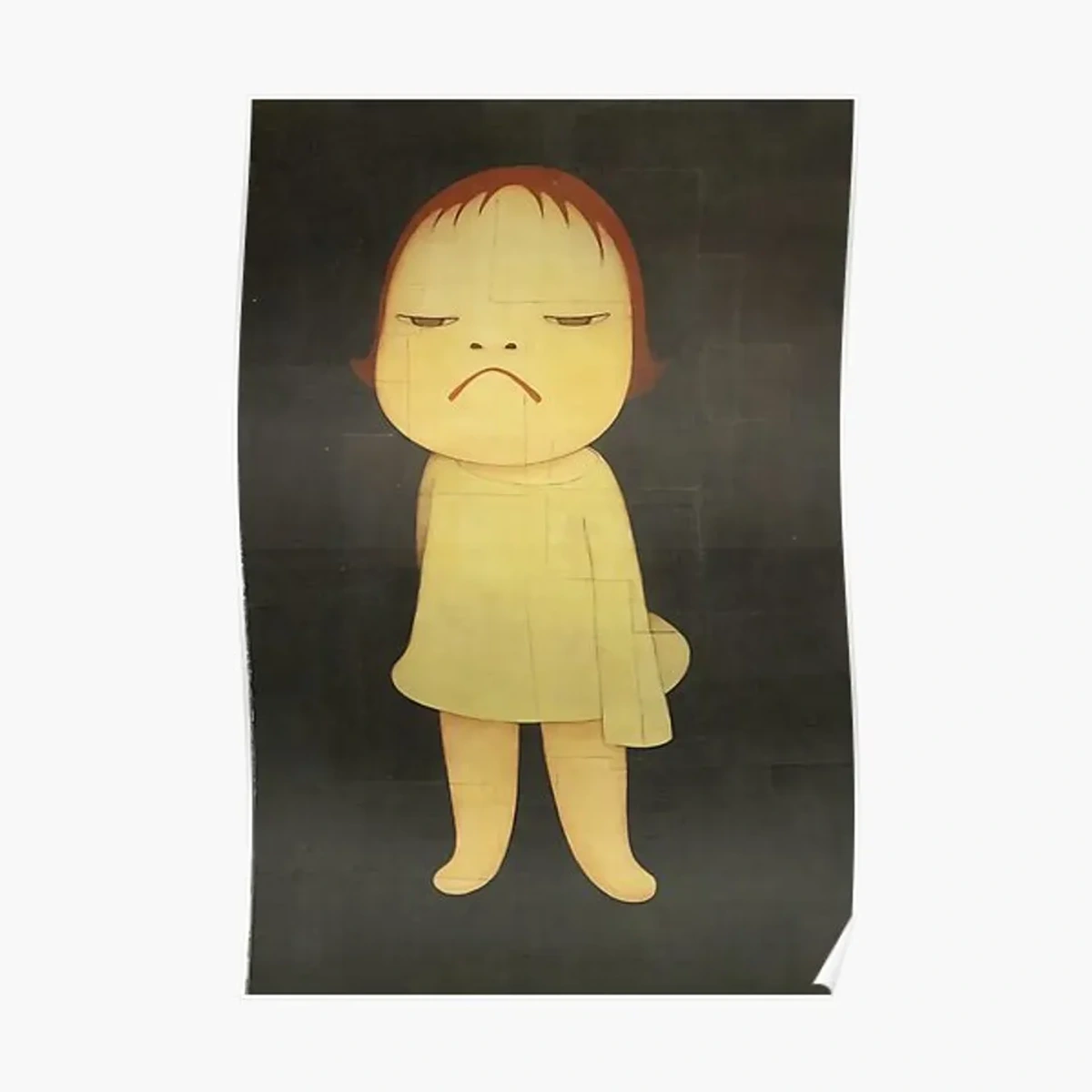
- Painting Technique: Nara often employs a seemingly simple, flat application of color, frequently using acrylics on canvas, wood, or found materials like cardboard boxes and envelopes. But that 'simple' look is so deceptive. Closer inspection, especially in later works, reveals subtle layering, visible brushstrokes, and textural variations that add depth and physicality. Early on, you might see rougher textures, almost like he's fighting the canvas. Later, especially after 2011, the surfaces become incredibly refined, sometimes with pearlescent finishes or subtle gradients built up in layers. He achieves these effects through careful application of thin washes of paint, sometimes sanding between layers to create a smooth, luminous surface that seems to glow from within. It’s less about flatness and more about a luminous depth. He often works on canvas, but also frequently uses wood panels, which give a different kind of solidity. And those found materials, like old envelopes or cardboard boxes, add another layer – a sense of history, of making do, that connects back to that DIY punk thing and his childhood.
- Drawing as Foundation: Drawing is fundamental to Nara's practice. It really feels like the core of his practice, doesn't it? Like unfiltered thoughts hitting the page. His drawings possess an immediacy and spontaneity, capturing raw emotion with economical lines. He draws prolifically on various surfaces, often seeing it as a direct form of communication. He uses everything – pencils, colored pencils, pens – on whatever's handy: notebook paper, envelopes, scraps of cardboard. Sometimes they feel like quick sketches, capturing a fleeting mood, other times they're more worked, almost like studies for paintings. You might see a simple line drawing on a crumpled envelope, or a more detailed colored pencil piece in a sketchbook – both feel equally direct and personal. They often have that raw energy, that punk spirit, even more directly than the paintings. It's where you see the immediacy most clearly, I think. For collectors looking for something more accessible than a major painting, these drawings, though often still expensive, offer a powerful connection to his process. You can explore various ways people start collecting, perhaps even starting an art collection on a budget.
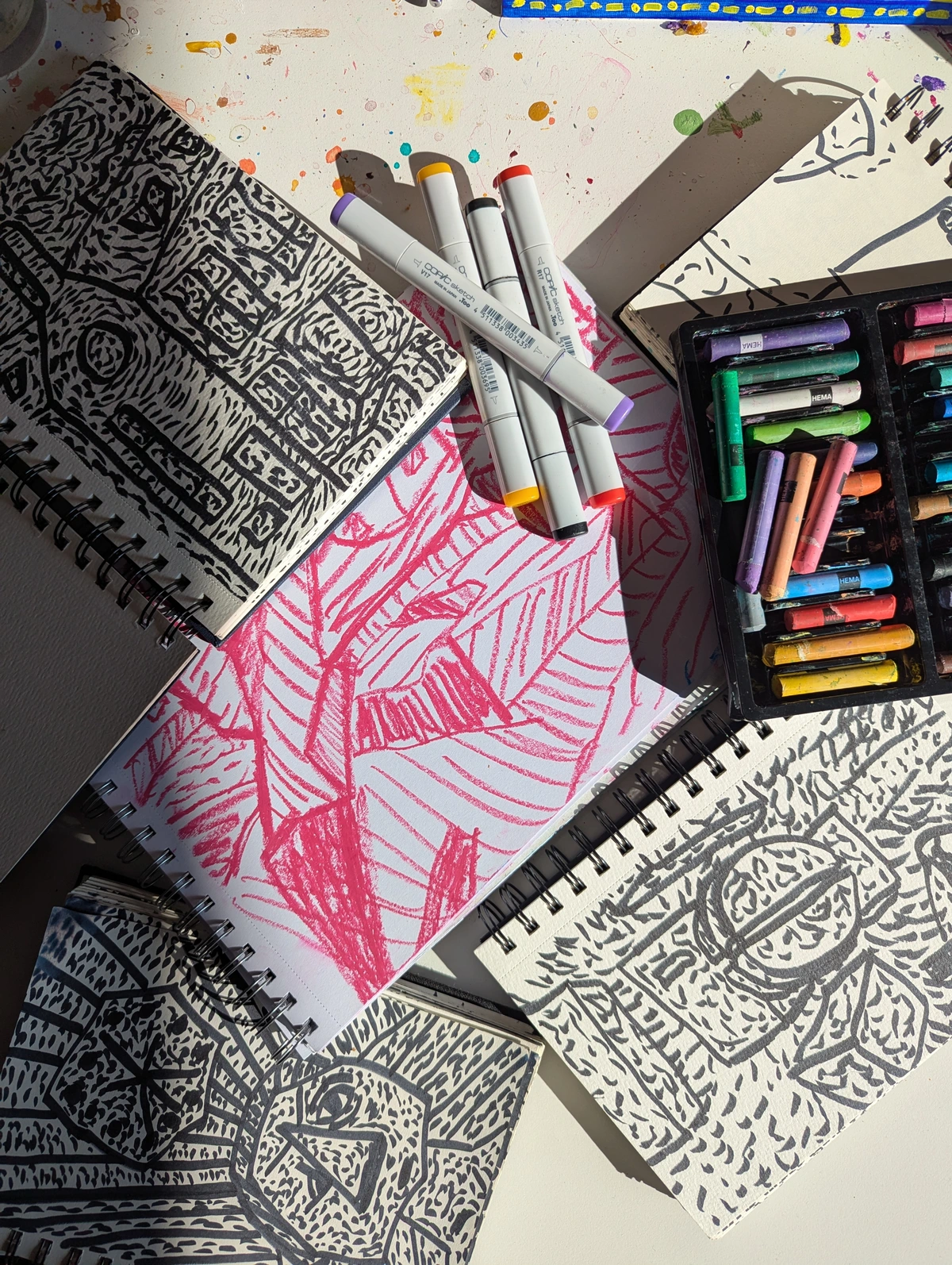
- Sculpture and Installation: Nara translates his iconic characters into three dimensions using materials like Fiberglass Reinforced Plastic (FRP), bronze, wood, and ceramics. His sculptures range from small figures to monumental outdoor installations. Translating those flat figures into 3D isn't easy, but Nara manages to keep that emotional punch, using materials like FRP (Fiberglass Reinforced Plastic) for smooth, almost cartoonish finishes, or bronze for a more traditional, weighty presence. He's also explored wood and ceramics, often giving the pieces a rougher, more handmade feel, which I personally find quite appealing – it feels closer to the immediacy of his drawings. He also creates 'little huts' or shacks, immersive installations that evoke childhood dens, creative isolation, and personal worlds. These huts are often large enough to walk into, creating an intimate, almost sacred space filled with drawings, objects, and music – a physical manifestation of his inner world. Seeing one of these large dogs or heads outdoors, it changes the feel entirely. It’s less confrontational than some paintings, maybe more like a silent, slightly melancholy guardian.
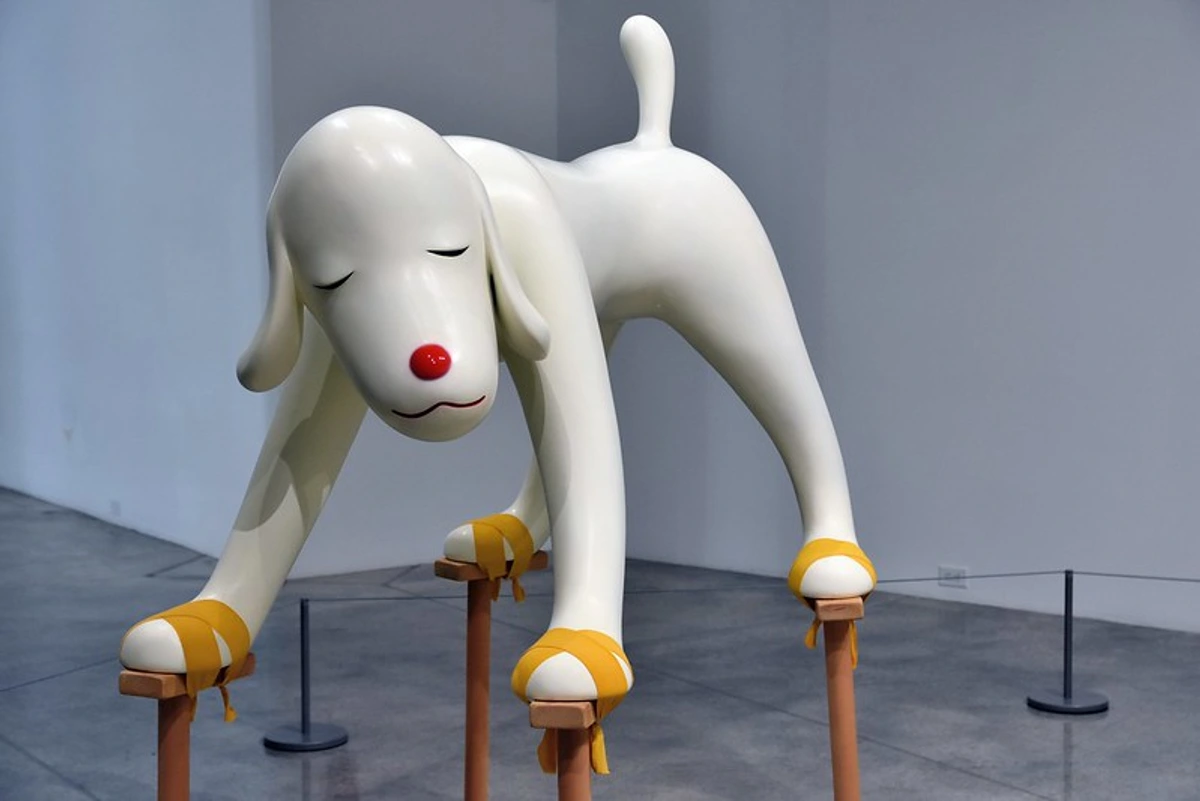
- Color Palette: While known for soft pastels, Nara also utilizes bold primary colors and sometimes stark black and white. Color choices are primarily emotive, contributing significantly to the mood of each piece rather than adhering to naturalism. He uses color almost like a language itself, isn't it? A bright red might signal anger or passion, while a soft blue could evoke calm or sadness.
- Text Integration: Often incorporates fragments of text (usually in English, sometimes Japanese or German) into his paintings and drawings. These phrases, frequently referencing song lyrics or expressing simple declarations, add another layer of meaning or emotional resonance, sometimes contrasting with the visual expression. It's like a little whisper or a shout added to the visual feeling.
Key Motifs and Iconography
Certain images recur throughout Nara's work, forming his core iconography – symbols that feel both deeply personal and universally resonant:
- The Lone Child: This is Nara's most defining motif. Often depicted alone against a blank background, the child confronts the viewer directly. Their large eyes convey a spectrum of complex emotions simultaneously. They might hold small objects (knives, saws, cigarettes, flowers) that add to the ambiguity – and how that ambiguity is part of the genius! Are they weapons, toys, or misunderstood symbols? Nara himself has often described these objects not as literal weapons, but as tools for self-protection or symbols of independence in a sometimes overwhelming world. They embody themes of independence, isolation, inner turmoil, and resilience.
- Animal Figures: Sleepy, passive dogs (often resembling the Spitz breed) are common companions or standalone subjects, perhaps representing loyalty, quiet observation, or even a projection of the artist's own feelings. These sleepy dogs feel like quiet, perhaps melancholic, companions or observers, don't they? Cats and sheep also appear occasionally, rendered with similar simplified forms and expressive potential. They seem to share the children's inner world, existing in that same space of quiet emotion.
- Little Huts/Installations: These structures, often built from reclaimed materials, function as both sculptures and environments. They reference childhood playhouses, makeshift shelters, and the artist's studio, creating spaces of imagination, solitude, and creative incubation. It's a conversational reflection on how these structures tap into a universal feeling of wanting a private space, a den for imagination or escape. They are physical spaces for the internal world.
Iconic Works: A Closer Look
While Nara has produced a vast body of work, certain pieces have become particularly emblematic of his style and themes. It's always tricky picking 'the best' – art hits everyone differently, right? But looking at a few key examples can really help understand his impact. Getting familiar with an artist's major works is a big part of researching artists before you buy.
- Knife Behind Back (2000): Perhaps his most famous painting, this work perfectly encapsulates the kawaii-kowai tension. A seemingly sweet girl in a red dress confronts the viewer with wide, challenging eyes, while hiding a small knife behind her back. Is she innocent, menacing, or simply self-protective? The ambiguity is the point. That image is instantly iconic and perfectly captures the kawaii-kowai tension in a single, unforgettable stare. The flat background and simple rendering focus all attention on her expression and the hidden object, making it an incredibly potent image of childhood defiance and hidden depths. It fetched a record-breaking price at auction, highlighting the intense demand for his major canvases on the secondary art market.
- Sleepless Night (Sitting) (1997): This piece shows a character sitting, head tilted, eyes wide and slightly dazed, conveying a sense of insomnia, boredom, or perhaps quiet contemplation. It captures that feeling of being awake in the quiet hours, lost in thought, connecting it to themes of introspection. The slightly rougher paint application typical of his German period adds to the emotional rawness.
- Your Dog (2002) / Large-Scale Dog Sculptures: Nara's monumental dog sculptures, often made of FRP or bronze, have become iconic public artworks. Smooth, white, and typically depicted with closed or sleepy eyes, they contrast with the often-angsty children. They radiate a sense of calm, perhaps a passive acceptance or gentle melancholy. Unlike the direct confrontation of the children, these dogs invite a quieter interaction, becoming peaceful landmarks in places like Aomori, Japan (his home prefecture) or N's YARD. There's a personal observation about the contrast between the quiet calm of the dogs and the intensity of the children, and how both feel equally essential to Nara's world. They embody that connection to animals from his youth and offer a different facet of his emotional spectrum.
- Missing in Action (2011): This painting, created shortly after the 2011 earthquake, exemplifies the shift in his post-disaster work. It depicts a child with eyes closed, head tilted slightly upward, seemingly lost in thought or looking towards the future rather than confronting the viewer. The colors are often softer, more layered, and the mood is distinctly more contemplative and melancholic, reflecting a deeper introspection prompted by the tragedy. It feels like a quiet sigh after a storm.
Major Themes in Nara's Work
Nara's seemingly simple figures tap into profound and universal themes that resonate because, well, we've all felt them, haven't we?:
- Childhood and Memory: Ah, childhood. Nara doesn't just show the sunny side, does he? He explores the complex emotional landscape of childhood – not just idealized innocence, but also frustration, boredom, anger, defiance, and vulnerability. His work often evokes a sense of nostalgia but tinged with the anxieties of growing up.
- Loneliness and Isolation: Loneliness... it's a quiet hum throughout his work, isn't it? A pervasive theme, likely rooted in his own childhood experiences, but resonating with broader feelings of alienation in contemporary society. His solitary figures often seem lost in their own worlds, inviting us into our own.
- Rebellion and Defiance: Influenced by the punk rock ethos, Nara's characters often display a subtle (or sometimes overt) rebelliousness against authority or societal expectations. Their unwavering gaze can feel confrontational, like a quiet refusal to conform.
- Communication (and its Absence): The figures rarely engage in dialogue. Meaning is conveyed through expression, posture, and context, highlighting the difficulties and nuances of non-verbal communication and inner emotional states. It's about what's felt, not necessarily what's said.
- Music's Power: Music, particularly punk, rock, and folk, is a constant source of art inspiration for Nara. It informs the attitude, titles, and emotional tone of his work, embodying a spirit of DIY creativity and emotional directness. You can almost feel the energy of a punk song or the introspection of a folk ballad when looking at certain pieces.
- Vulnerability and Resilience: Despite sometimes appearing tough or angry, Nara's figures often betray an underlying vulnerability. This duality speaks to the complexities of inner strength and coping mechanisms. They are tough because they are vulnerable, perhaps?
Influences: Shaping the Nara Universe
Nara's unique style is a synthesis of diverse influences, a melting pot of personal history and cultural touchstones:
- Music: This is arguably the most significant influence. Punk rock bands like The Ramones, Sex Pistols, The Clash, and Japanese punk provide an attitude, energy, and lyrical snippets. Folk and rock music contribute to the melancholic and introspective moods. Album cover art also informs his visual sensibilities. It's the soundtrack to his creative process.
- Childhood Experiences: His solitary upbringing, connection with animals, and engagement with popular culture (children's books, television) are directly channelled into his art. That feeling of being alone with your imagination is palpable.
- Manga and Anime: While stylistic similarities exist (simplified features, large eyes), Nara's work differs significantly. He uses that familiar visual language and imbues it with a depth and raw emotion you don't typically find in mainstream examples. Crucially, his figures often lack the complex narratives or dynamic action typical of manga/anime panels, reinforcing his focus on static, emotional portraits rather than storytelling.
- Children's Book Illustrations: The simplified characters, clear lines, and often strong emotional expressions found in children's book illustrations likely played a role in shaping his visual language and his ability to convey complex feelings through seemingly simple forms. Think of the directness of classic storybook characters.
- Traditional Japanese Art: Influences from Ukiyo-e woodblock prints can be seen in his use of bold outlines and flat areas of color. That graphic quality has deep roots.
- Western Art History: His time in Germany exposed him to German Neo-Expressionism. Echoes of folk art, outsider art (see Best Outsider Artists), and even Early Renaissance masters (like Giotto, whom he has cited) can be detected in the directness and emotionality of his figures – who knew Giotto and The Ramones had so much in common? It's about that raw, unfiltered feeling.
Evolution of Work and Style
Nara's work has evolved subtly over his career, each period reflecting shifts in his life and perspective:
- Early Work (Germany, 1988-2000): Figures were sometimes more overtly aggressive or crudely rendered, carrying a strong sense of punk defiance and raw energy. His painting technique showed more visible layering and texture as he developed his style away from academic constraints, almost like he was figuring things out directly on the canvas.
- Mid-Career (2000s): Refinement of the iconic Nara character, becoming instantly recognizable globally. This period saw increased global recognition and large-scale exhibitions, alongside continued prolific output in drawing and painting. Development of larger sculptural forms became more prominent, bringing his characters into physical space.
- Post-2011 Earthquake: A noticeable shift towards more contemplative, introspective, and sometimes melancholic figures. Eyes might be closed or gazing forward/upward rather than directly confronting the viewer, conveying a sense of quiet resilience and reflection. Exploration of more complex, jewel-like color palettes and textured surfaces in paintings emerged, adding a new depth and luminosity. Increased production of ceramic sculptures also marked this period, perhaps drawn to the tactile, earthy nature of the material.
Nara in the Context of Japanese Contemporary Art
So, where does Nara fit in the big picture of Japanese art? You often hear him mentioned alongside broader movements, but his place is unique.
- Superflat: Coined by Takashi Murakami, Superflat refers to an aesthetic characterized by flatness (influenced by anime/manga and traditional Japanese art) and often engages with consumer culture and otaku (geek) subcultures. While Nara shares the flattened aesthetic and pop culture influences, his focus is more on individual psychology, existential themes, and punk rebellion rather than Murakami's broader critique of consumerism and otaku culture. Think of it this way: if Murakami's work is a vibrant, complex social commentary on modern Japan, Nara's is a deeply personal diary entry, using a similar visual language but with a focus squarely on inner feeling.
- Neo-Pop: Nara emerged alongside artists reacting to Japan's post-war economic boom and Western cultural influence. His use of accessible, character-based imagery fits within a Neo-Pop context, but his emphasis on personal emotion and introspection distinguishes him from artists more focused on surface-level pop commentary. He takes the 'pop' aesthetic and makes it profoundly human.
Global Recognition and Market Status
Yoshitomo Nara is a major international art star, which is kind of wild when you think about the quiet, solitary nature of his subjects:
- Exhibitions & Collections: His work has been featured in solo and group exhibitions at prestigious institutions worldwide, including MoMA (New York), LACMA (Los Angeles), and the Art Institute of Chicago. His art is held in numerous major public and private collections globally. You can find information on notable institutions in guides to the best museums for modern art.
- Market Value: Nara is one of the most commercially successful contemporary artists from Japan. His paintings, drawings, and sculptures command high prices at auction and through primary market galleries, often reaching millions of dollars. Factors influencing value are discussed in understanding art prices. It's kind of wild how his market exploded, isn't it? Seeing his characters become such global icons feels... significant. What drives these prices? It's a mix: his unique, instantly recognizable style bridging pop and psychological depth; his massive global fanbase; strong representation by top galleries; and critical acclaim from major institutions. Rarity plays a role too, especially for key early works or large canvases. And, of course, provenance (the history of ownership) and condition are absolutely crucial factors that significantly impact the price of any artwork on the market. The emotional connection people feel with his characters is huge – they're not just decorative, they resonate deeply. You see shifts in value too, like the increased appreciation for works showing that post-2011 contemplative shift. Understanding these nuances is key if you're exploring art as an investment, though I always think buying what you love should come first.
- Gallery Representation: He is represented by influential international galleries such as Pace Gallery and Blum & Poe.
- Collecting Nara: Original paintings and large sculptures are significant investments, typically acquired through top galleries or the secondary art market. Drawings, limited edition prints, smaller sculptures, and official merchandise (posters, figures, etc.) offer more accessible ways for fans and collectors to own a piece of Nara's world, though even prints have become highly collectible. And then there's the merchandise. From posters and postcards sold at museum shops during exhibitions, to vinyl figures, plush toys, skateboards, apparel, and even stationery, Nara's imagery is everywhere. This accessibility is part of his appeal, letting fans bring a piece of his world home without needing millions. It reinforces that link between fine art and popular culture. Be aware, though, its popularity means counterfeits are common, especially online. Always buy merchandise from reputable sources like official museum stores, gallery shops (like Pace or Blum & Poe), or authorized retailers associated with N's YARD or specific projects. If you're looking for original works or limited editions, exploring options to buy art online through trusted platforms or gallery websites is possible, but requires diligence. If considering a purchase, researching the artist and specific work is crucial. Understanding the distinction between original works and prints is key when exploring how to buy art or even just browsing art for sale.
Legacy and Impact
Yoshitomo Nara's influence extends across the art world and popular culture, leaving a mark that feels both quiet and profound:
- He successfully bridged the gap between contemporary art ("high" art) and popular visual culture (manga, illustration, merchandise), making his work accessible yet critically respected.
- His instantly recognizable characters have become global icons, resonating with audiences through their potent blend of cuteness and complex emotion.
- He has inspired countless younger artists working with character design, simplified figuration, and the exploration of psychological states. His impact can be seen not just in fine art galleries but also in areas like illustration, character design, and even street art.
- He reaffirmed the power of painting and drawing to convey profound emotion in a direct, seemingly simple manner. His work serves as rich art inspiration. His work resonates so deeply because it gives voice to those quiet, complex inner feelings we all have, bridging the gap between personal experience and universal emotion. It's a journey we're all on, in our own way, isn't it?
Experiencing Yoshitomo Nara's Art
To fully appreciate Nara's work, experiencing it in person is highly recommended. There's a different kind of connection when you stand before the actual piece:
- Where to See: Besides major museum collections, N's YARD in Nasushiobara, Tochigi, Japan, offers a unique look into Nara's world, featuring his works, personal record collection, and influences. This place, N's YARD, it’s not just a museum. It feels more like stepping into Nara’s personal world, which is pretty special. Located in Nasushiobara, Tochigi, north of Tokyo, it’s a bit of a pilgrimage for fans. Designed by Graf, it houses not just his own paintings, drawings, and sculptures (including works not often seen elsewhere), but also his massive record collection, personal objects, and works by artists he admires. It’s like visiting his dream studio-cum-gallery. You get a real sense of the things that feed his creativity – the music, the folk art, the everyday objects. It’s less formal than a typical museum, more intimate. Definitely worth the trip if you're a serious fan. Check the websites of Pace Gallery and Blum & Poe for current and upcoming exhibitions, or look for his work in major collections like the one at the Zen Museum in 's-Hertogenbosch.
- Tips for Viewing: Okay, so you're standing in front of a Nara piece. What should you look for? Here are a few suggestions for a richer personal experience:
- Look Beyond Cuteness: First off, try to look past the cute surface appeal. Engage with the figure's gaze and posture. What do they seem to be feeling?
- Consider the Emotion: What feelings does the work evoke in you? Anger? Sadness? Defiance? Ambiguity? There's no single right answer.
- Note the Details: Pay attention to the handling of paint, the quality of line in drawings, any integrated text, and the chosen materials. Understanding how to read a painting or drawing applies here – the details tell a story.
- Consider the Space: Pay attention to the background or the space surrounding the figure. The negative space is often as important as the figure itself in conveying isolation, vulnerability, or mood.
- Embrace Simplicity: Appreciate how Nara conveys complex ideas with economical means. Sometimes less really is more.
- Contextualize: Seeing Nara's work within a museum setting, perhaps alongside other contemporary or historical art, can provide valuable perspective.
Conclusion
Yoshitomo Nara has created one of the most distinctive and emotionally resonant visual languages in contemporary art. His wide-eyed figures, born from personal experiences of solitude, a love for punk rock, and a unique blend of cultural influences, capture the complexities of childhood, rebellion, and the universal search for connection. He stands as a testament to the power of seemingly simple images to convey profound psychological depth, securing his place as a truly global and influential artist for our time. For me, his work is a reminder that even in quiet moments of isolation, there's a whole universe of feeling waiting to be explored, and sometimes, all it takes is a simple line or a wide-eyed stare to connect us to it. It's a journey we're all on, in our own way, isn't it?
Frequently Asked Questions (FAQ)
- What does Yoshitomo Nara's art mean? Nara's art doesn't have one single meaning – and that's part of its magic! It explores complex themes like loneliness, alienation, rebellion, childhood anxiety, innocence, and resilience. The ambiguity of his characters' expressions invites viewers to project their own feelings and interpretations onto the work. It's less about his meaning and more about what it means to you.
- Is Yoshitomo Nara Pop Art or Superflat? While influenced by popular culture (like Pop Art) and sharing aesthetic similarities with Superflat (flatness, manga influence), Nara's work is distinct. It's generally considered Neo-Pop but stands apart due to its strong emphasis on individual psychology, raw emotion, and punk ethos rather than direct critiques of consumerism or otaku culture central to Superflat. He uses the visual language, but the feeling is different.
- Why do Nara's characters look angry or sad? Their expressions are intentionally complex and ambiguous. They reflect the often-overlooked difficult emotions of childhood – frustration, defiance, sadness, boredom – alongside innocence and vulnerability. Kids aren't always sunshine and rainbows, right? Nara gets that. His characters challenge simplistic notions of childhood as purely happy.
- Is Nara influenced by manga/anime? Yes, the stylization (simplified forms, large heads, prominent eyes) draws from manga and anime aesthetics, which were part of his visual environment growing up. However, he uses this accessible style to explore much deeper and more personal psychological themes than typical mainstream examples. He takes that familiar look and gives it a raw, emotional punch.
- What materials does Nara typically use? Nara works across various media. For paintings, he primarily uses acrylics on canvas or wood panels, sometimes incorporating mixed media elements. His drawings utilize pencils, colored pencils, and pens on paper, envelopes, or cardboard. His sculptures are made from materials like Fiberglass Reinforced Plastic (FRP), bronze, wood, and ceramics.
- What are Yoshitomo Nara's most famous works? Some iconic pieces include the painting Knife Behind Back (2000), Sleepless Night (Sitting) (1997), and his large-scale dog sculptures like Your Dog (often seen at N's YARD or Aomori Museum of Art). His characters are widely recognizable across paintings, drawings, and sculptures. But honestly, sometimes it's a lesser-known drawing that really grabs you.
- Where can I see Yoshitomo Nara's work? His work is in major international museums (MoMA, LACMA, Tate, etc.), his personal museum N's YARD in Japan, and exhibited through Pace Gallery and Blum & Poe. Check museum and gallery websites for current displays. And don't forget places like the Zen Museum in 's-Hertogenbosch which might have pieces in their collection or exhibitions.
- How much is Yoshitomo Nara's art worth? His original paintings and sculptures are highly valuable, often selling for millions of dollars at auction. Drawings and prints are also highly sought after and can range from tens of thousands to hundreds of thousands of dollars, depending on rarity and significance. It's a serious market! Learn more about art valuation.
- Where can I buy Yoshitomo Nara art/merchandise? Original artworks are primarily available through his representing galleries (Pace, Blum & Poe) and major auction houses on the secondary market. Limited edition prints and multiples are sometimes released through galleries or specialized print publishers. Official merchandise (posters, toys, apparel, etc.) is often available through museum shops during exhibitions or via authorized online retailers – but please, be cautious of counterfeit goods! Always buy from reputable sources. Explore options for buying art, including potentially accessible prints online.
- Is Yoshitomo Nara merchandise considered 'real' art? The merchandise (toys, posters, etc.) allows broader access to Nara's imagery but is distinct from his original paintings, drawings, sculptures, and limited edition prints, which are considered fine art and hold significant collector value. The merchandise is officially licensed and appreciated by fans, but it's mass-produced, unlike the unique or limited-edition artworks sought by collectors navigating the art market. Think of it like band merch vs. a signed guitar – both cool, but different things.




